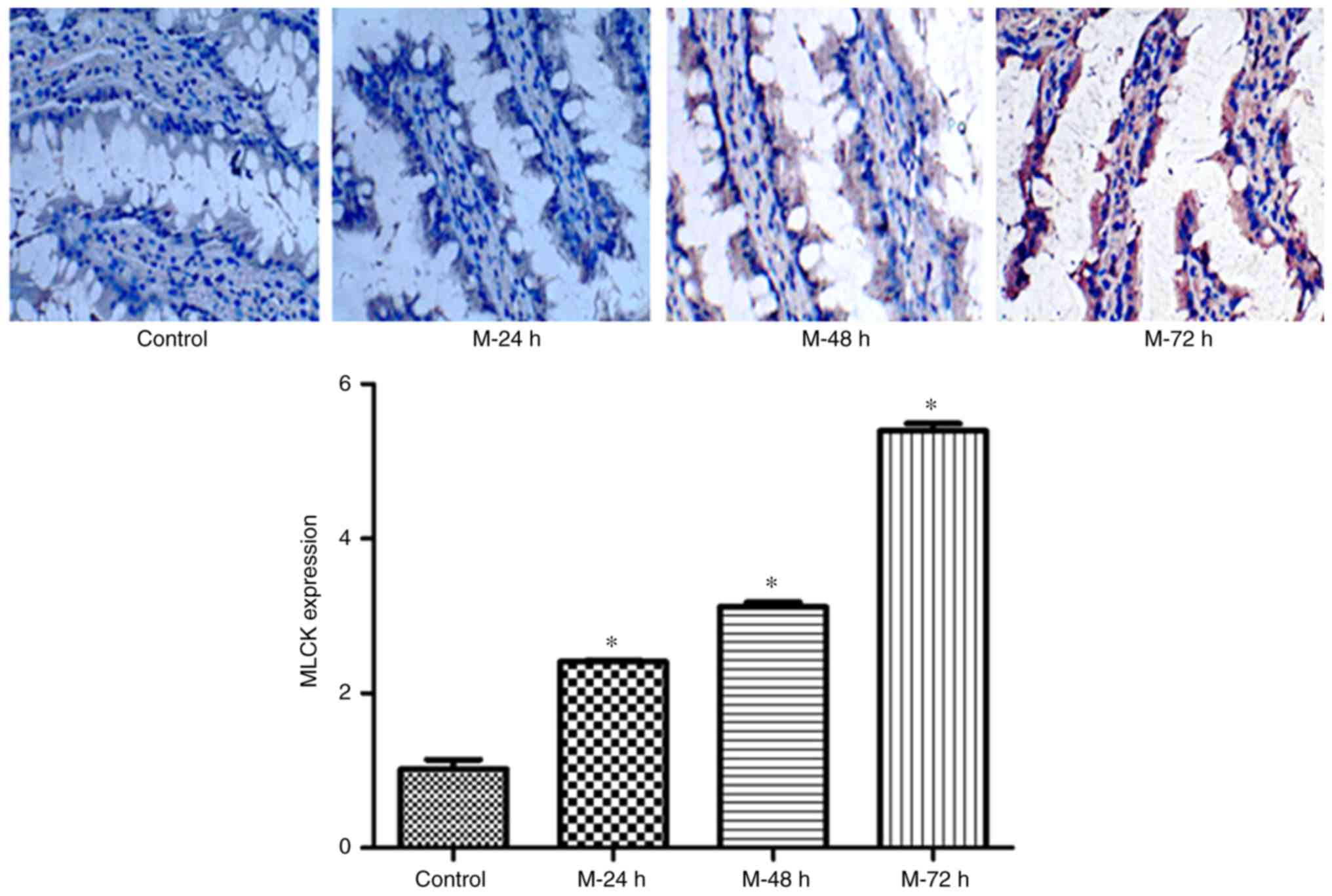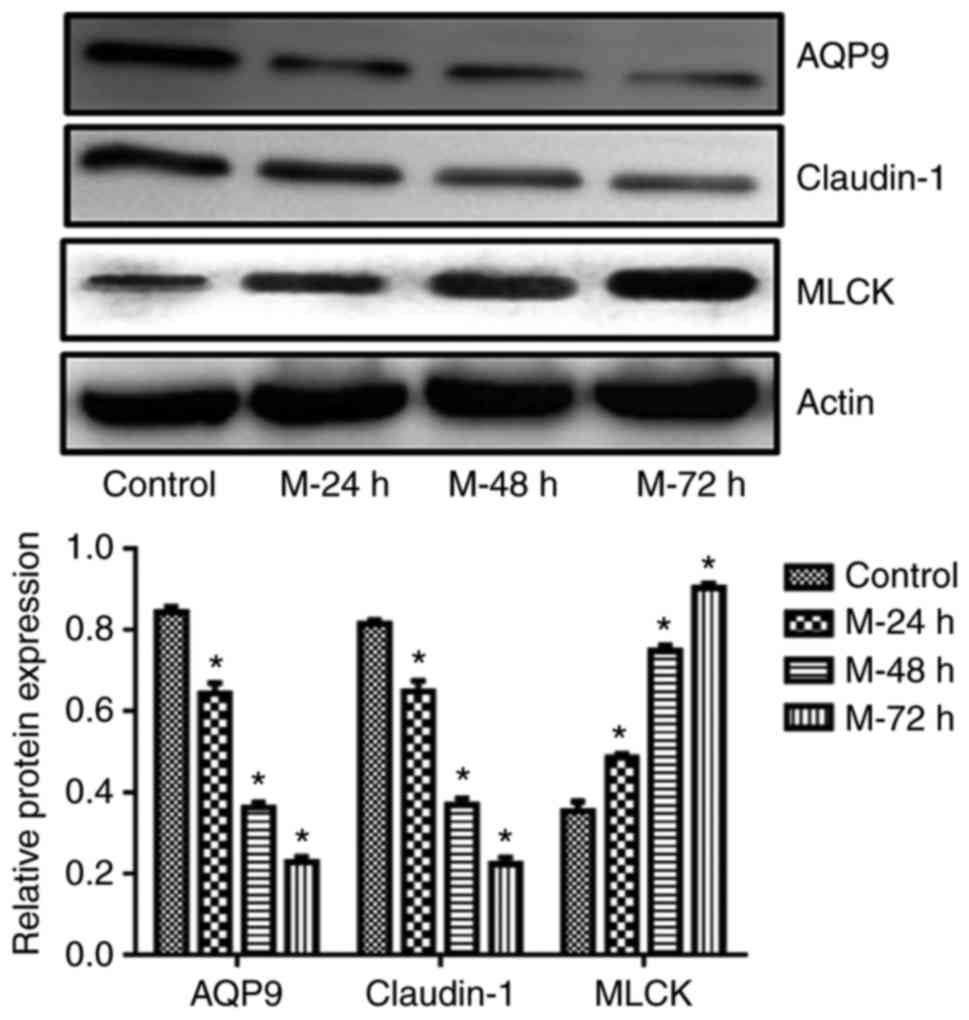|
1
|
Suzuki T: Regulation of intestinal
epithelial permeability by tight junctions. Cell Mol Life Sci.
70:631–659. 2013. View Article : Google Scholar : PubMed/NCBI
|
|
2
|
Dokladny K, Zuhl MN and Moseley PL:
Intestinal epithelial barrier function and tight junction proteins
with heat and exercise. J Appl Physiol (1985). 120:692–701. 2016.
View Article : Google Scholar : PubMed/NCBI
|
|
3
|
Muto S: Physiological roles of claudins in
kidney tubule paracellular transport. Am J Physiol Renal Physiol.
312:F9–F24. 2017. View Article : Google Scholar : PubMed/NCBI
|
|
4
|
Khan N and Asif AR: Transcriptional
regulators of claudins in epithelial tight junctions. Mediators
Inflamm. 2015:2198432015. View Article : Google Scholar : PubMed/NCBI
|
|
5
|
Gan H, Wang G, Hao Q, Wang QJ and Tang H:
Protein kinase D promotes airway epithelial barrier dysfunction and
permeability through down-regulation of claudin-1. J Biol Chem.
288:37343–37354. 2013. View Article : Google Scholar : PubMed/NCBI
|
|
6
|
Ohta A, Yang SS, Rai T, Chiga M, Sasaki S
and Uchida S: Overexpression of human WNK1 increases paracellular
chloride permeability and phosphorylation of claudin-4 in MDCKII
cells. Biochem Biophys Res Commun. 349:804–808. 2006. View Article : Google Scholar : PubMed/NCBI
|
|
7
|
Du J, Chen Y, Shi Y, Liu T, Cao Y, Tang Y,
Ge X, Nie H, Zheng C and Li YC: 1,25-Dihydroxyvitamin D protects
intestinal epithelial barrier by regulating the myosin light chain
kinase signaling pathway. Inflamm Bowel Dis. 21:2495–2506. 2015.
View Article : Google Scholar : PubMed/NCBI
|
|
8
|
Xiong Y, Wang J, Chu H, Chen D and Guo H:
Salvianolic acid B restored impaired barrier function via
downregulation of MLCK by microRNA-1 in rat colitis model. Front
Pharmacol. 7:1342016. View Article : Google Scholar : PubMed/NCBI
|
|
9
|
Takata K, Matsuzaki T and Tajika Y:
Aquaporins: Water channel proteins of the cell membrane. Prog
Histochem Cytochem. 39:1–83. 2004. View Article : Google Scholar : PubMed/NCBI
|
|
10
|
Carbrey JM, Gorelick-Feldman DA, Kozono D,
Praetorius J, Nielsen S and Agre P: Aquaglyceroporin AQP9: Solute
permeation and metabolic control of expression in liver. Proc Natl
Acad Sci U S A. 100:2945–2950. 2003. View Article : Google Scholar : PubMed/NCBI
|
|
11
|
Lindskog C, Asplund A, Catrina A, Nielsen
S and Rutzler M: A systematic characterization of aquaporin-9
expression in human normal and pathological tissues. J Histochem
Cytochem. 64:287–300. 2016. View Article : Google Scholar : PubMed/NCBI
|
|
12
|
Rojek AM, Skowronski MT, Fuchtbauer EM,
Füchtbauer AC, Fenton RA, Agre P, Frøkiaer J and Nielsen S:
Defective glycerol metabolism in aquaporin 9 (AQP9) knockout mice.
Proc Natl Acad Sci U S A. 104:3609–3614. 2007. View Article : Google Scholar : PubMed/NCBI
|
|
13
|
Spegel P, Chawade A, Nielsen S, Kjellbom P
and Rutzler M: Deletion of glycerol channel aquaporin-9 (Aqp9)
impairs long-term blood glucose control in C57BL/6 leptin
receptor-deficient (db/db) obese mice. Physiol Rep. 3:e125382015.
View Article : Google Scholar : PubMed/NCBI
|
|
14
|
Okada S, Misaka T, Matsumoto I, Watanabe H
and Abe K: Aquaporin-9 is expressed in a mucus-secreting goblet
cell subset in the small intestine. FEBS Lett. 540:157–162. 2003.
View Article : Google Scholar : PubMed/NCBI
|
|
15
|
Matsuzaki T, Tajika Y, Ablimit A, Aoki T,
Hagiwara H and Takata K: Aquaporins in the digestive system. Med
Electron Microsc. 37:71–80. 2004. View Article : Google Scholar : PubMed/NCBI
|
|
16
|
Liu W, Hou S, Yan J, Zhang H, Ji Y and Wu
X: Quantification of proteins using enhanced etching of Ag coated
Au nanorods by the Cu(2+)/bicinchoninic acid pair with improved
sensitivity. Nanoscale. 8:780–784. 2016. View Article : Google Scholar : PubMed/NCBI
|
|
17
|
Rudler M, Mouri S, Charlotte F, Lebray P,
Capocci R, Benosman H, Poynard T and Thabut D: Prognosis of treated
severe alcoholic hepatitis in patients with gastrointestinal
bleeding. J Hepatol. 62:816–821. 2015. View Article : Google Scholar : PubMed/NCBI
|
|
18
|
Konno R, Yamakawa H, Utsunomiya H, Ito K,
Sato S and Yajima A: Expression of survivin and Bcl-2 in the normal
human endometrium. Mol Hum Reprod. 6:529–534. 2000. View Article : Google Scholar : PubMed/NCBI
|
|
19
|
Zhang C, Li Y, Zhang XY, Liu L, Tong HZ,
Han TL, Li WD, Jin XL, Yin NB, Song T, et al: Therapeutic potential
of human minor salivary gland epithelial progenitor cells in liver
regeneration. Sci Rep. 7:127072017. View Article : Google Scholar : PubMed/NCBI
|
|
20
|
Elamin E, Masclee A, Troost F, Pieters HJ,
Keszthelyi D, Aleksa K, Dekker J and Jonkers D: Ethanol impairs
intestinal barrier function in humans through mitogen activated
protein kinase signaling: A combined in vivo and in vitro approach.
PloS One. 9:e1074212014. View Article : Google Scholar : PubMed/NCBI
|
|
21
|
Armand-Lefevre L, Angebault C, Barbier F,
Hamelet E, Defrance G, Ruppé E, Bronchard R, Lepeule R, Lucet JC,
El Mniai A, et al: Emergence of imipenem-resistant gram-negative
bacilli in intestinal flora of intensive care patients. Antimicrob
Agents Chemother. 57:1488–1495. 2013. View Article : Google Scholar : PubMed/NCBI
|
|
22
|
Resino E, San-Juan R and Aguado JM:
Selective intestinal decontamination for the prevention of early
bacterial infections after liver transplantation. World J
Gastroenterol. 22:5950–5957. 2016. View Article : Google Scholar : PubMed/NCBI
|
|
23
|
Baranova IN, Souza AC, Bocharov AV,
Vishnyakova TG, Hu X, Vaisman BL, Amar MJ, Chen Z, Kost Y, Remaley
AT, et al: Human SR-BI and SR-BII potentiate
lipopolysaccharide-induced inflammation and acute liver and kidney
injury in mice. J Immunol. 196:3135–3147. 2016. View Article : Google Scholar : PubMed/NCBI
|
|
24
|
de Medina Sanchez F, Romero-Calvo I,
Mascaraque C and Martinez-Augustin O: Intestinal inflammation and
mucosal barrier function. Inflamm Bowel Dis. 20:2394–2404. 2014.
View Article : Google Scholar : PubMed/NCBI
|
|
25
|
Pelaseyed T, Bergstrom JH, Gustafsson JK,
Ermund A, Birchenough GM, Schütte A, van der Post S, Svensson F,
Rodríguez-Piñeiro AM, Nyström EE, et al: The mucus and mucins of
the goblet cells and enterocytes provide the first defense line of
the gastrointestinal tract and interact with the immune system.
Immunol Rev. 260:8–20. 2014. View Article : Google Scholar : PubMed/NCBI
|
|
26
|
Turner JR: Intestinal mucosal barrier
function in health and disease. Nat Rev Immunol. 9:799–809. 2009.
View Article : Google Scholar : PubMed/NCBI
|
|
27
|
Wang X, Yan S, Xu D, Li J, Xie Y, Hou J,
Jiang R, Zhang C and Sun B: Aggravated liver injury but attenuated
inflammation in PTPRO-deficient mice following LPS/D-GaIN induced
fulminant hepatitis. Cell Physiol Biochem. 37:214–224. 2015.
View Article : Google Scholar : PubMed/NCBI
|
|
28
|
Yu C, Tan S, Zhou C, Zhu C, Kang X, Liu S,
Zhao S, Fan S, Yu Z, Peng A and Wang Z: Berberine reduces
uremia-associated intestinal mucosal barrier damage. Biol Pharm
Bull. 39:1787–1792. 2016. View Article : Google Scholar : PubMed/NCBI
|
|
29
|
Li HC, Fan XJ, Chen YF, Tu JM, Pan LY,
Chen T, Yin PH, Peng W and Feng DX: Early prediction of intestinal
mucosal barrier function impairment by elevated serum procalcitonin
in rats with severe acute pancreatitis. Pancreatology. 16:211–217.
2016. View Article : Google Scholar : PubMed/NCBI
|
|
30
|
Tan SJ, Yu C, Yu Z, Lin ZL, Wu GH, Yu WK,
Li JS and Li N: High-fat enteral nutrition reduces intestinal
mucosal barrier damage after peritoneal air exposure. J Surg Res.
202:77–86. 2016. View Article : Google Scholar : PubMed/NCBI
|
|
31
|
Wen JB, Zhu FQ, Chen WG, Jiang LP, Chen J,
Hu ZP, Huang YJ, Zhou ZW, Wang GL, Lin H and Zhou SF: Oxymatrine
improves intestinal epithelial barrier function involving
NF-κB-mediated signaling pathway in CCl4-induced cirrhotic rats.
PLoS One. 9:e1060822014. View Article : Google Scholar : PubMed/NCBI
|
|
32
|
Chen J, Zhang R, Wang J, Yu P, Liu Q, Zeng
D, Song H and Kuang Z: Protective effects of baicalin on
LPS-induced injury in intestinal epithelial cells and intercellular
tight junctions. Can J Physiol Pharmacol. 93:233–237. 2015.
View Article : Google Scholar : PubMed/NCBI
|
|
33
|
Zong X, Hu W, Song D, Li Z, Du H, Lu Z and
Wang Y: Porcine lactoferrin-derived peptide LFP-20 protects
intestinal barrier by maintaining tight junction complex and
modulating inflammatory response. Biochem Pharmacol. 104:74–82.
2016. View Article : Google Scholar : PubMed/NCBI
|
|
34
|
Saeedi BJ, Kao DJ, Kitzenberg DA,
Dobrinskikh E, Schwisow KD, Masterson JC, Kendrick AA, Kelly CJ,
Bayless AJ, Kominsky DJ, et al: HIF-dependent regulation of
claudin-1 is central to intestinal epithelial tight junction
integrity. Mol Biol Cell. 26:2252–2262. 2015. View Article : Google Scholar : PubMed/NCBI
|
|
35
|
Al-Sadi R, Guo S, Ye D, Rawat M and Ma TY:
TNF-α modulation of intestinal tight junction permeability is
mediated by NIK/IKK-α axis activation of the canonical NF-κB
pathway. Am J Pathol. 186:1151–1165. 2016. View Article : Google Scholar : PubMed/NCBI
|
|
36
|
Liu R, Li X, Huang Z, Zhao D, Ganesh BS,
Lai G, Pandak WM, Hylemon PB, Bajaj JS, Sanyal AJ and Zhou H: C/EBP
homologous protein-induced loss of intestinal epithelial stemness
contributes to bile duct ligation-induced cholestatic liver injury
in mice. Hepatology. 67:1441–1457. 2018. View Article : Google Scholar : PubMed/NCBI
|
|
37
|
Al-Sadi R, Guo S, Ye D and Ma TY: TNF-α
modulation of intestinal epithelial tight junction barrier is
regulated by ERK1/2 activation of Elk-1. Am J Pathol.
183:1871–1884. 2013. View Article : Google Scholar : PubMed/NCBI
|
|
38
|
Guérin CF, Regli L and Badaut J: Roles of
aquaporins in the brain. Med Sci (Paris). 21:747–752. 2005.(In
French). View Article : Google Scholar : PubMed/NCBI
|
|
39
|
Dibas A, Yang MH, Bobich J and Yorio T:
Stress-induced changes in neuronal Aquaporin-9 (AQP9) in a retinal
ganglion cell-line. Pharmacol Res. 55:378–384. 2007. View Article : Google Scholar : PubMed/NCBI
|
|
40
|
Chen XF, Li CF, Lu L and Mei ZC:
Expression and clinical significance of aquaglyceroporins in human
hepatocellular carcinoma. Mol Med Rep. 13:5283–5289. 2016.
View Article : Google Scholar : PubMed/NCBI
|
|
41
|
Liu Z, Carbrey JM, Agre P and Rosen BP:
Arsenic trioxide uptake by human and rat aquaglyceroporins. Biochem
Biophys Res Commun. 316:1178–1185. 2004. View Article : Google Scholar : PubMed/NCBI
|
|
42
|
Tsukaguehi H, Weremowiez S, Morton CC and
Hediger MA: Funetional and molecular characterization of the human
neutral solute channel aquaporin-9. Am J Physiol. 277:F685–F696.
1999.PubMed/NCBI
|
|
43
|
Yang M, Gao F, Liu H, Yu WH, Zhuo F, Qiu
GP, Ran JH and Sun SQ: Hyperosmotic induction of aquaporin
expression in rat astrocytes through a different MAPK pathway. J
Cell Biochem. 114:111–119. 2013. View Article : Google Scholar : PubMed/NCBI
|
|
44
|
Lei Q, Qiang F, Chao D, Di W, Guoqian Z,
Bo Y and Lina Y: Amelioration of hypoxia and LPS-induced intestinal
epithelial barrier dysfunction by emodin through the suppression of
the NF-kappaB and HIF-1alpha signaling pathways. Int J Mol Med.
34:1629–1639. 2014. View Article : Google Scholar : PubMed/NCBI
|


















